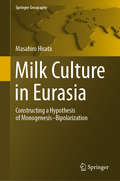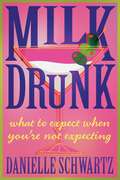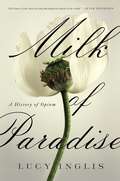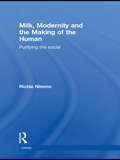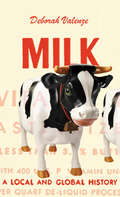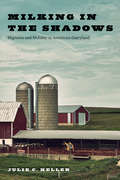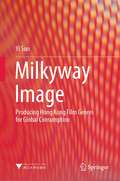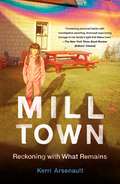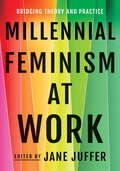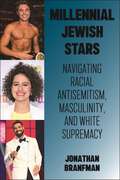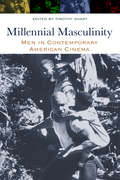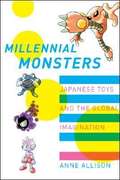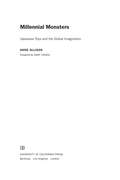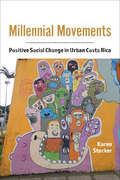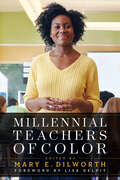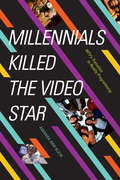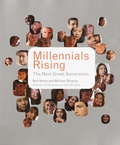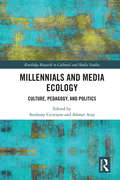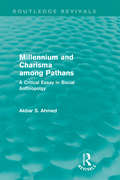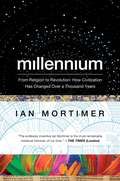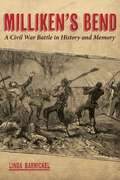- Table View
- List View
Milk Culture in Eurasia: Constructing a Hypothesis of Monogenesis–Bipolarization (Springer Geography)
by Masahiro HirataThe invention of milking and milk use created a new mode of subsistence called pastoralism. On rangelands across Eurasia, pastoralists subsist by extensive animal husbandry and by processing their animals’ milk. Based on the author’s fieldwork over more than two decades, this book details the processing systems and uses of milk observed in pastoralist and farm households in West Asia, South Asia, North Asia, Central Asia, the Tibetan Plateau, and Europe and the Caucasus. Milk culture in each region is characterized by its processing technology and use of milk, and characteristics common to wider geographical spheres are identified. Inclusion of case studies from the literature expands the continent-wide perspective and provides further indications of how milk culture developed and diffused historically. The inferences drawn are expressed in the author’s monogenesis–bipolarization hypothesis of Eurasian milk culture, that milking and milk processing had a single center of origin in West Asia, and that the technology involved the spread from there across the continent, developing distinct characteristics in northern and southern spheres. Finally, because milk culture underpins pastoralism as a mode of subsistence, the typology and theory of pastoralism are re-examined from the standpoint of milk culture.
Milk Drunk: What to Expect When You're Not Expecting
by Danielle SchwartzFor generations, expectations for a "good" life in America have remained the same: go to college, get a job, find a partner, get married, and have children. But what happens if someone decides to accomplish all of those things except have a child?In Milk Drunk: What to Expect When You Are Not Expecting, Danielle Schwartz details her very fulfilling but child-free life with her husband, Jim, while facing constant criticism about their family decision. By sharing conversations with friends, family, coworkers, and even strangers, Milk Drunk explores a wide array of topics and opinions. Some people view Danielle as strong and independent for knowing who she is and what she wants, while others believe her choice is "disappointing God" and attempt to convince her that as a woman, she "must use God's given gift" of fertility. Milk Drunk: What to Expect When You Are Not Expecting explores a slew of opinions surrounding the sensitive and personal topic of remaining child-free and provides insight for those who either need support in a similar decision or do not understand why someone they know or love has turned down the choice of parenthood.
Milk of Paradise: A History Of Opium
by Lucy InglisAn intelligent and authoritative history of opium—a drug that has both healed and harmed since the beginning of civilization. Poppy tears, opium, heroin, fentanyl: humankind has been in thrall to the “Milk of Paradise” for millennia. The latex of papaver somniferum is a bringer of sleep, of pleasurable lethargy, of relief from pain—and hugely addictive. A commodity without rival, it is renewable, easy to extract, transport, and refine, and subject to an insatiable global demand. No other substance in the world is as simple to produce or as profitable. It is the basis of a gargantuan industry built upon a shady underworld, but ultimately it is an agricultural product that lives many lives before it reaches the branded blister packet, the intravenous drip, or the scorched and filthy spoon. Many of us will end our lives dependent on it. In Milk of Paradise, acclaimed cultural historian Lucy Inglis takes readers on an epic journey from ancient Mesopotamia to modern America and Afghanistan, from Sanskrit to pop, from poppy tears to smack, from morphine to today’s synthetic opiates. It is a tale of addiction, trade, crime, sex, war, literature, medicine, and, above all, money. And, as this ambitious, wide-ranging, and compelling account vividly shows, the history of opium is our history and it speaks to us of who we are.
Milk, Modernity and the Making of the Human: Purifying the Social (CRESC)
by Richie NimmoThis book undertakes a critique of the pervasive notion that human beings are separate from and elevated above the nonhuman world and explores its role in the constitution of modernity. The book presents a socio-material analysis of the British milk industry in the late nineteenth and early twentieth centuries. It traces the dramatic development of the milk trade from a cottage industry into a modernised and integrated system of production and distribution, examining the social, economic and political factors underpinning this transformation, and also highlighting the important roles played by various nonhumans, such as microbes, refrigeration technologies, diseases, and even cows themselves. Milk as a substance posed deep social and material problems for modernity, being hard to transport and keep fresh as well as a highly fertile environment for the growth of bacteria and the transmission of diseases such as tuberculosis from cows to humans. Milk, Modernity and the Making of the Human demonstrates how the resulting insecurities and dilemmas posed a threat to the nature/culture divide as milk consumption grew along with urbanization, and had therefore to be managed by emergent forms of scientific and sanitary knowledge and expertise. Milk, Modernity and the Making of the Human is an ideal volume for any researcher interested in the hybrid socio-material, economic and political factors underpinning the transformation of the milk industry.
Milk: A Local and Global History
by Deborah ValenzeThe illuminating history of milk, from ancient myth to modern grocery store.How did an animal product that spoils easily, carries disease, and causes digestive trouble for many of its consumers become a near-universal symbol of modern nutrition? In the first cultural history of milk, historian Deborah Valenze traces the rituals and beliefs that have governed milk production and consumption since its use in the earliest societies.Covering the long span of human history, Milk reveals how developments in technology, public health, and nutritional science made this once-rare elixir a modern-day staple. The book looks at the religious meanings of milk, along with its association with pastoral life, which made it an object of mystery and suspicion during medieval times and the Renaissance. As early modern societies refined agricultural techniques, cow's milk became crucial to improving diets and economies, launching milk production and consumption into a more modern phase. Yet as business and science transformed the product in the nineteenth and twentieth centuries, commercial milk became not only a common and widely available commodity but also a source of uncertainty when used in place of human breast milk for infant feeding. Valenze also examines the dairy culture of the developing world, looking at the example of India, currently the world's largest milk producer.Ultimately, milk&’s surprising history teaches us how to think about our relationship to food in the present, as well as in the past. It reveals that although milk is a product of nature, it has always been an artifact of culture.
Milk: An Intimate History of Breastfeeding
by Joanna WolfarthWhen Joanna Wolfarth was pregnant with her first child, she assumed she would breastfeed, as her mother had fed her. Yet she was unprepared for the startling realities of new motherhood. Then, just four weeks after the birth, she found herself back in hospital with an underweight baby, bewildered by inconsistent advice and overcome with feelings of guilt and isolation.Months later, her cultural historian's impulse led her to look to the past for guidance. What she discovered, neglected in the archives, amazed and reassured her. By piecing together cultural debris - from fragments of ancient baby bottles to eighteenth-century breast pumps, from the Palaeolithic Woman of Willendorf figurine to the poignantly inventive work of Louise Bourgeois and from mythical accounts of the creation of the Milky Way to advice found in Victorian medical manuals - Joanna began to understand how feeding our babies can be culturally, economically and physiologically determined as well as deeply personal and emotive.Using the arc of her own experience, Joanna takes us on an intimate journey of discovery beyond mother and baby, asking how the world views caregivers, their bodies, their labour and their communal bonds. By bringing together art, social histories, philosophy, folk wisdom and contemporary interviews with women from across the world, Milk reveals how infant feeding has been represented and repressed, celebrated and censured. In doing so, Joanna charts previously unexplored territory and offers comfort and solace to anyone who has fed or will feed a child.
Milking in the Shadows: Migrants and Mobility in America’s Dairyland (Inequality at Work: Perspectives on Race, Gender, Class, and Labor)
by Julie C. KellerMigrant workers live in a transnational world that spans the boundaries of nation-states. Yet for undocumented workers, this world is complicated by inflexible immigration policies and the ever-present threat of enforcement. Workers labeled as “illegals” wrestle with restrictive immigration policies, evading border patrol and local police as they risk their lives to achieve economic stability for their families. For this group of workers, whose lives in the U.S. are largely defined by their tenuous legal status, the sacrifices they make to get ahead entail long periods of waiting, extended separation from family, and above all, tremendous uncertainty around a freedom that many of us take for granted—everyday mobility. In Milking in the Shadows, Julie Keller takes an in-depth look at a population of undocumented migrants working in the American dairy industry to understand the components of this labor system. This book offers a framework for understanding the disjuncture between the labor desired by employers and life as an undocumented worker in America today.
Milkyway Image: Producing Hong Kong Film Genres for Global Consumption
by Yi SunThis book adopts an integrative research framework that primarily combines industrial and discourse analysis to investigate the company Milkyway Image, drawing upon literature that studies film studios and the practices of film production, distribution, and reception. The history of the Hong Kong-based film production company Milkyway Image from its founding in 1996 to the present exemplifies the metamorphosis of the post-return Hong Kong film industry to an era characterised by Hong Kong’s integration into a Chinese national context and the transnationalisation of world cinema. It shows that contemporary Hong Kong cinema’s transition resists a monolithic chronicle and instead represents a narrative combining the perspectives of different interest groups and a complex process of compliance and resistance, negotiation and contestation. The meaning of Milkyway’s films shifts as they are circulated across cultures and viewed within diverse frameworks, and our understanding of Hong Kong cinema is subject to varying contexts and historical configurations. For researchers in film and media studies and those who have a general interest in Hong Kong cinema, Asian cinema, or contemporary film culture, this book reveals how a variety of industry and cultural bodies have become co-creators of meaning for a film production house, and how the company operates as a co-creator of the discourse that surrounds it.
Mill Town: Reckoning with What Remains
by Kerri ArsenaultA galvanizing and powerful debut, Mill Town is an American story, a human predicament, and a moral wake-up call that asks: what are we willing to tolerate and whose lives are we willing to sacrifice for our own survival?Kerri Arsenault grew up in the rural working class town of Mexico, Maine. For over 100 years the community orbited around a paper mill that employs most townspeople, including three generations of Arsenault’s own family. Years after she moved away, Arsenault realized the price she paid for her seemingly secure childhood. The mill, while providing livelihoods for nearly everyone, also contributed to the destruction of the environment and the decline of the town’s economic, physical, and emotional health in a slow-moving catastrophe, earning the area the nickname “Cancer Valley.”Mill Town is a personal investigation, where Arsenault sifts through historical archives and scientific reports, talks to family and neighbors, and examines her own childhood to illuminate the rise and collapse of the working-class, the hazards of loving and leaving home, and the ambiguous nature of toxins and disease. Mill Town is a moral wake-up call that asks, Whose lives are we willing to sacrifice for our own survival?
Mill and Paternalism
by Gregory ClaeysMany discussions of J. S. Mill's concept of liberty focus too narrowly on On Liberty and fail to acknowledge that his treatment of related issues elsewhere may modify its leading doctrines. Mill and Paternalism demonstrates how a contextual reading suggests that in Principles of Political Economy, and also his writings on Ireland, India and on domestic issues like land reform, Mill proposed a substantially more interventionist account of the state than On Liberty seems to imply. This helps to explain Mill's sympathies for socialism after 1848, as well as his Malthusianism and feminism, which, in conjunction with Harriet Taylor's views, are central to his later discussions of the family and marriage. Feminism, indeed, is shown to provide the answer to the problem which most agitated Mill, overpopulation. Thus Gregory Claeys sheds new lights on many of Mill's overarching preoccupations, including the theory of liberty at the heart of On Liberty.
Mill on Justice (Philosophers in Depth)
by L. KahnJohn Stuart Mill was one of the most important figures in political philosophy but little has been published on his ideas on justice. This impressive collection by renowned Mill scholars addresses this gap in Mill studies and theories of justice.
Millennial Feminism at Work: Bridging Theory and Practice
by Jane JufferIn Millennial Feminism at Work, volume editor Jane Juffer brings together recently graduated students from across the US to reflect on the relevance of their feminist studies programs in their chosen career paths. The result is a dynamic collection of voices, shaking up preconceived ideas and showing the positive influence of gender and sexuality studies on individuals at work.Encompassing five areas—corporate, education, nonprofit, medical, and media careers—these engaging essays use personal experiences to analyze the pressure on young adults to define themselves through creative work, even when that job may not sustain them financially. Obstacles to feminist work conditions notwithstanding, they urge readers to never downplay their feminist credentials and prove that gender and sexuality studies degrees can serve graduates well in the current marketplace and prepare them for life outside of their alma mater. Emphasizing the importance of individual stories situated within political and economic structures, Millennial Feminism at Work provides spirited collective advice and a unique window into the lives and careers of young feminists sharing the lessons they have learned.Contributors: Rose Al Abosy, Rachel Cromidas, Lauren Danzig, Sadaf Ferdowsi, Reina Gattuso, Jael Goldfine, Sassafras Lowrey, Alissa Medina, Samuel Naimi, Stephanie Newman, Justine Parkin, Lily Pierce, Kate Poor, Laura Ramos-Jaimes, Savannah Taylor, Addie Tsai, Hayley Zablotsky
Millennial Jewish Stars: Navigating Racial Antisemitism, Masculinity, and White Supremacy
by Jonathan BranfmanHighlights how millennial Jewish stars symbolize national politics in US mediaJewish stars have longed faced pressure to downplay Jewish identity for fear of alienating wider audiences. But unexpectedly, since the 2000s, many millennial Jewish stars have won stellar success while spotlighting (rather than muting) Jewish identity. In Millennial Jewish Stars, Jonathan Branfman asks: what makes these explicitly Jewish stars so unexpectedly appealing? And what can their surprising success tell us about race, gender, and antisemitism in America? To answer these questions, Branfman offers case studies on six top millennial Jewish stars: the biracial rap superstar Drake, comedic rapper Lil Dicky, TV comedy duo Abbi Jacobson and Ilana Glazer, “man-baby” film star Seth Rogen, and chiseled film star Zac Efron.Branfman argues that despite their differences, each star’s success depends on how they navigate racial antisemitism: the historical notion that Jews are physically inferior to Christians. Each star especially navigates racial stigmas about Jewish masculinity—stigmas that depict Jewish men as emasculated, Jewish women as masculinized, and both as sexually perverse. By embracing, deflecting, or satirizing these stigmas, each star comes to symbolize national hopes and fears about all kinds of hot-button issues. For instance, by putting a cuter twist on stereotypes of Jewish emasculation, Seth Rogen plays soft man-babies who dramatize (and then resolve) popular anxieties about modern fatherhood. This knack for channeling national dreams and doubts is what makes each star so unexpectedly marketable.In turn, examining how each star navigates racial antisemitism onscreen makes it easier to pinpoint how antisemitism, white privilege, and color-based racism interact in the real world. Likewise, this insight can aid readers to better notice and challenge racial antisemitism in everyday life.
Millennial Masculinity: Men in Contemporary American Cinema
by Timothy SharyIn virtually every aspect of culture-health, marriage, family, morals, politics, sex, race, economics-American men of the past two decades have faced changing social conditions and confronted radical questions about themselves. In Millennial Masculinity: Men in Contemporary American Cinema, editor Timothy Shary collects fourteen contributions that consider male representation in films made at the turn of the century to explore precisely how those questions have been dealt with in cinema. Contributors move beyond the recent wave of "masculinity in crisis" arguments to provide sophisticated and often surprising insight into accessible films. Chapters are arranged in four sections: "Performing Masculinity" includes a discussion of Adam Sandler and movies such as Milk; "Patriarchal Problems" looks at issues of fathers from directors such as Martin Scorsese, Wes Anderson, and David Fincher; "Exceptional Sexualities" examines male love and sex through movies like Brokeback Mountain and Wedding Crashers; and "Facing Race" explores masculinity through race in film. Sean Penn, Jackie Chan, Brad Pitt, Will Smith, and Philip Seymour Hoffman are some of the actors included in these analyses, while themes considered include police thrillers, psychotic killers, gay tensions, fashion sense, and the burgeoning "bromance" genre. Taken together, the essays in Millennial Masculinity shed light on the high stakes of masculine roles in contemporary American cinema. Film and television scholars as well as readers interested in gender and sexuality in film will appreciate this timely collection.
Millennial Monsters: Japanese Toys and the Global Imagination
by Anne AllisonMillennial Monsters explores the global popularity of Japanese youth goods today while it questions the make-up of the fantasies and the capitalistic conditions of the play involved. Arguing that part of the appeal of such dream worlds is the polymorphous perversity with which they scramble identity and character, the author traces the postindustrial milieu from which such fantasies have arisen in postwar Japan and been popularly received in the United States.
Millennial Monsters: Japanese Toys and the Global Imagination
by Anne Allison Gary CrossFrom sushi and karaoke to martial arts and technoware, the currency of made-in-Japan cultural goods has skyrocketed in the global marketplace during the past decade. The globalization of Japanese "cool" is led by youth products: video games, manga (comic books), anime (animation), and cute characters that have fostered kid crazes from Hong Kong to Canada. Examining the crossover traffic between Japan and the United States, Millennial Monsters explores the global popularity of Japanese youth goods today while it questions the make-up of the fantasies and the capitalistic conditions of the play involved. Arguing that part of the appeal of such dream worlds is the polymorphous perversity with which they scramble identity and character, the author traces the postindustrial milieux from which such fantasies have arisen in postwar Japan and been popularly received in the United States.
Millennial Movements: Positive Social Change in Urban Costa Rica (Teaching Culture: UTP Ethnographies for the Classroom)
by Karen StockerThrough social movements that are both grassroots and global, young leaders in San José, Costa Rica, have sought to create positive social change in their communities. Using social media, art, local organizations, corporations, and government entities, these leaders have found creative ways to connect with and support one another’s efforts to promote change and tackle growing concerns, including environmental sustainability, freedom from sexual assault, food security, LGBTQ+ rights, and more. Presenting case studies of Costa Rican millennial leaders, Millennial Movements shows how youth activists in San José draw from global solutions to address the local problems inhabiting their city. Identifying with the youths that they encounter in each chapter, students will be inspired by the strategies and skills used by these leaders and can adapt them to their own schools and communities.
Millennial Teachers of Color (Race and Education)
by Mary E. Dilworth2019 Outstanding Book Award, American Association of Colleges for Teacher Education (AACTE)Millennial Teachers of Color explores the opportunities and challenges for creating and sustaining a healthy teaching force in the United States. Millennials are the largest generational cohort in American history, with approximately ninety million members and, of these, roughly 43 percent are people of color. This book, edited by prominent teacher educator Mary E. Dilworth, considers the unique qualities, challenges, and opportunities posed by that large population for the teaching field. Noting that a diverse teaching and learning community enhances student achievement, particularly for the underserved and underachieving preK–12 student population, Dilworth argues that efforts to recruit, groom, and retain teachers of color are out-of-date and inadequate. She and the contributors offer fresh looks at these millennials and explore their views of the teaching profession; focus attention on their relation to schools and teaching; and consider how these young teachers feel about teaching for social justice. The book is intended to disrupt the current line of inquiry that suggests that by simply increasing the number of teachers of color equity has been established. Readers will gain insights on this unique and valuable group of prospective and practicing preK–12 educators and understanding of the need for more contemporary approaches to recruitment, preparation, hiring, and placement.Contributors Keffrelyn D. BrownKeith C. CatoneGenesis A. ChavezMarcus J. ColemanHollee R. FreemanMichael HansenSocorro G. HerreraSarah IshmaelSabrina Hope KingAdam T. Kuranishi Lindsay A. MillerAmanda R. MoralesJanice Hamilton OuttzZollie Stevenson Jr.Dulari TahbildarAngela M. Ward
Millennials Killed the Video Star: MTV's Transition to Reality Programming
by Amanda Ann KleinBetween 1995 and 2000, the number of music videos airing on MTV dropped by 36 percent. As an alternative to the twenty-four-hour video jukebox the channel had offered during its early years, MTV created an original cycle of scripted reality shows, including Laguna Beach, The Hills, The City, Catfish, and Jersey Shore, which were aimed at predominantly white youth audiences. In Millennials Killed the Video Star Amanda Ann Klein examines the historical, cultural, and industrial factors leading to MTV's shift away from music videos to reality programming in the early 2000s and 2010s. Drawing on interviews with industry workers from programs such as The Real World and Teen Mom, Klein demonstrates how MTV generated a coherent discourse on youth and identity by intentionally leveraging stereotypes about race, ethnicity, gender, and class. Klein explores how this production cycle, which showcased a variety of ways of being in the world, has played a role in identity construction in contemporary youth culture—ultimately shaping the ways in which Millennial audiences of the 2000s thought about, talked about, and embraced a variety of identities.
Millennials Rising: The Next Great Generation
by William Strauss Neil HoweBy the authors of the bestselling 13th Gen, the first in-depth examination of the Millennials--the generation born after 1982. "Over the next decade, the Millennial Generation will entirely recast the image of youth from downbeat and alienated to upbeat and engaged--with potentially seismic consequences for America." --from Millennials Rising. In this remarkable account, certain to stir the interest of educators, counselors, parents, and people in all types of business as well as young people themselves, Neil Howe and William Strauss introduce the nation to a powerful new generation: the Millennials. They will also explain: Why today's teens are smart, well-behaved, and optimistic, and why you won't hear older people say that. Why they get along so well with their Boomer and Xer parents. Why Millennial collegians will bring a new youth revolution to America's campuses. Why names like "Generation Y" and "Echo Boom" just don't work for today's kids. Having looked at oceans of data, taken their own polls, and talked to hundreds of kids, parents, and teachers, Howe and Strauss explain how Millennials are turning out to be so dramatically different from Xers and boomers and how, in time, they will become the next great generation.
Millennials and Media Ecology: Culture, Pedagogy, and Politics (Routledge Research in Cultural and Media Studies)
by Ahmet Atay Anthony CristianoMillennials and Media Ecology explores issues pertaining to millennials and digital media ecology and studies the cultural, pedagogical, and political environments such heterogeneous generation populates. The book questions whether millennials are properly understood as a heterogeneous group, particularly by the institutions and agencies that target them, and whether they are demonstrating the ability to set out a path for themselves and take charge of their own life and future. A diverse team of expert authors review past and current studies with critical assessment of arguments and propositions, and document actual experiences of members of the millennial generation through detailed studies. Engaging with topical subject matter and current research on millennials, the chapters: Question the misunderstanding that digital tools and Internet technologies are making the younger generation ‘dumber’ and ‘disengaging’ them from the real world Underscore the legal and economic insights into the commodification of the younger generation as consumers rather than learners Examine the historical trajectory of media technology, and whether new practices are having an empowering effect or one of enslavement to an increasingly irreversible technological and socio-political regime Shed light on issues of critical pedagogy emerging from digital environments in relation to one’s mental abilities and degrees of wisdom Discuss the cultural and political implications of millennials’ new media trends, the changing relationship between millennials and legacy media, which rely on the younger generation for survival;Offer new insights into the significance of current media trends in relation to issue of credibility and identity. This is an essential book for scholars in the fields of Media and Communications and Popular Culture, and will be vital reading for postgraduate students and specialists in related fields.
Millennium and Charisma Among Pathans: A Critical Essay in Social Anthropology (Routledge Revivals)
by Akbar AhmedFirst published in 1976, this Routledge Revivals reissue presents an analysis of the Swat Pathans, the people of the North-West Frontier Province of Pakistan, who belong administratively to Pakistan despite being a fiercely independent group, with their own codes and ways of life. Akbar S. Ahmed, who knows the Swat Pathans well through his family connections, presents a clear and sophisticated analysis of their complex society. The study provides an anthropological and critical re-examination of the ethnography of the Swat Pathans and the author suggests specific alternative models of social organization. The book also represents an important contribution to the general debate in the social sciences between the ‘methodological individualists’ and the ‘methodological holists’, and challenges some of the theoretical and methodological premises in anthropology. In particular the author is critical of Professor Fredrik Barth’s study of Swat Pathans, for he believes that the ‘Swat models’ have inadvertently become the basis for generalized, and often incorrect, understanding of models of Pathan socio-political organization in the social sciences.
Millennium, Messiahs, and Mayhem: Contemporary Apocalyptic Movements
by Thomas Robbins Susan J. PalmerFirst Published in 1997. Routledge is an imprint of Taylor & Francis, an informa company.
Millennium: How Civilization Has Changed Over a Thousand Years
by Ian MortimerHistory's greatest tour guide, Ian Mortimer, takes us on an eye-opening and expansive journey through the last millennium of human innovation. In Millennium, bestselling historian Ian Mortimer takes the reader on a whirlwind tour of the last ten centuries of Western history. It is a journey into a past vividly brought to life and bursting with ideas, that pits one century against another in his quest to measure which century saw the greatest change. We journey from a time when there was a fair chance of your village being burned to the ground by invaders -- and dried human dung was a recommended cure for cancer -- to a world in which explorers sailed into the unknown and civilizations came into conflict with each other on an epic scale. Here is a story of godly scientists, fearless adventurers, cold-hearted entrepreneurs, and strong-minded women -- a story of discovery, invention, revolution, and cataclysmic shifts in perspective. Millennium is a journey into the past like no other. Our understanding of human development will never be the same again, and the lessons we learn along the way are profound ones for us all.
Milliken's Bend: A Civil War Battle in History and Memory
by Linda BarnickelAt Milliken's Bend, Louisiana, a Union force composed predominantly of former slaves met their Confederate adversaries in one of the bloodiest engagements of the war. This small yet important fight received some initial widespread attention but soon drifted into obscurity. In Milliken's Bend, Linda Barnickel uncovers the story of this long-forgotten and highly controversial battle.The fighting at Milliken's Bend occurred in June 1863, about fifteen miles north of Vicksburg on the west bank of the Mississippi River, where a brigade of Texas Confederates attacked a Federal outpost. Most of the Union defenders had been slaves less than two months before. The new African American recruits fought well, despite their minimal training, and Milliken's Bend helped prove to a skeptical northern public that black men were indeed fit for combat duty. After the battle, accusations swirled that Confederates had executed some prisoners taken from the "Colored Troops." The charges eventually led to a congressional investigation and contributed to the suspension of prisoner exchanges between North and South. Barnickel's compelling and comprehensive account of the battle illuminates not only the immense complexity of the events that transpired in northeastern Louisiana during the Vicksburg Campaign but also the implications of Milliken's Bend upon the war as a whole. The battle contributed to southerners' increasing fears of slave insurrection and heightened their anxieties about emancipation. In the North, it helped foster a commitment to allow free blacks and former slaves to take part in the war to end slavery. And for African Americans, both free and enslaved, Milliken's Bend symbolized their never-ending struggle for freedom.
